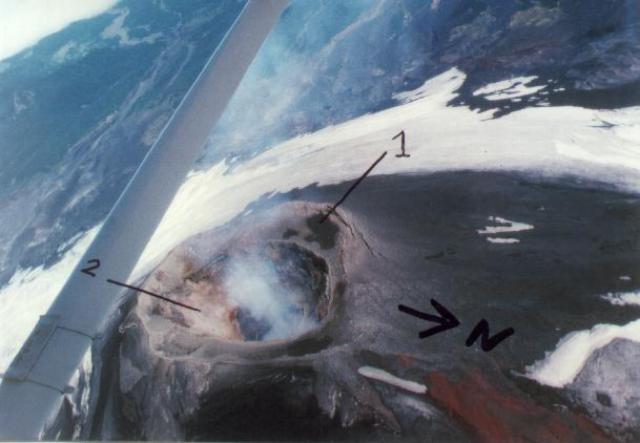Report on Villarrica (Chile) — April 1997
Bulletin of the Global Volcanism Network, vol. 22, no. 4 (April 1997)
Managing Editor: Richard Wunderman.
Villarrica (Chile) Strombolian activity and lava in central pit; red glow returns at night
Please cite this report as:
Global Volcanism Program, 1997. Report on Villarrica (Chile) (Wunderman, R., ed.). Bulletin of the Global Volcanism Network, 22:4. Smithsonian Institution. https://doi.org/10.5479/si.GVP.BGVN199704-357120
Villarrica
Chile
39.42°S, 71.93°W; summit elev. 2847 m
All times are local (unless otherwise noted)
In October and November 1996, activity was characterized by a rapidly convecting lava lake that nearly filled the central crater pit (BGVN 21:12). Fountains were noted on the lake's surface and frequent bursts ejected spatter and incandescent bombs beyond the summit crater. In December, the magmatic column subsided and the characteristic nocturnal crater glow disappeared. During the first two weeks of January 1997, incandescent lava returned to the central pit (BGVN 21:12). The following summarizes observations made from mid- January through mid-March by volcano guides Victor Sepulveda and Lorena Morales and documentary film makers.
The volcano guides reported that between 15 and 19 January few observations of the crater were made because of strong fumarolic activity. On 21 January a clear view revealed that the crater was unchanged since 13 January (BGVN 21:12). That day two small ash emissions from the summit crater were seen from Pucon, ~ 17 km N. The cause of these emissions may have been a landslide in the E crater, detected on 27 January. On 3 February, the crater floor was partially covered with talus, but a small vent was actively degassing in the N part of the crater floor. Another significant collapse of the NE crater wall occurred sometime before 15 February. By 17 February, two vents on the NE side of the crater floor had small Strombolian eruptions and extruded incandescent lava onto the crater floor. On 22 February, small lava fountains on the NE side of the crater floor were actively filling the crater with lava.
On 24 February, the guides reported that the crater floor had risen by several meters and convection was occurring within the lava pond. The film crew noted that two red spots in the crater produced irregular Strombolian activity, gas emissions, and strong noises. The film crew also reported that strong sulfur emissions required them to wear gas masks while at the summit and that these emissions appeared to be extruded from vents at the ash-covered icefields on the upper terrace in the crater (figure 7, number 1).
During late February the film crew reported seeing a light red glow at night above Villarrica's summit crater. These reports were confirmed by the volcano guides report of residents in Pucon seeing the glow on 2 March following several months of absence.
The documentary film crew took a summit overflight on 2 March and reported a change in crater morphology due to the collapse of the S terrace (figure 7, number 2). When they returned to the summit on 5 March there were no further morphological changes in the crater and degassing appeared the same as on 24 February.
On 12 March, the volcano guides observed a light dusting of ash that covered the NE flank of the volcano. Strombolian explosions from a vent on the crater floor continued throughout the remainder of March.
Geological Summary. The glacier-covered Villarrica stratovolcano, in the northern Lakes District of central Chile, is ~15 km south of the city of Pucon. A 2-km-wide caldera that formed about 3,500 years ago is located at the base of the presently active, dominantly basaltic to basaltic andesite cone at the NW margin of a 6-km-wide Pleistocene caldera. More than 30 scoria cones and fissure vents are present on the flanks. Plinian eruptions and pyroclastic flows that have extended up to 20 km from the volcano were produced during the Holocene. Lava flows up to 18 km long have issued from summit and flank vents. Eruptions documented since 1558 CE have consisted largely of mild-to-moderate explosive activity with occasional lava effusion. Glaciers cover 40 km2 of the volcano, and lahars have damaged towns on its flanks.
Information Contacts: Werner Keller, Wiesenstr. 8, 86438 Kissing, Germany; Boris Behncke, Geomar Research Center for Marine Geosciences, Wischhofstrasse 1-3, 24148 Kiel, Germany; Monika Steinmetz and Jürgen Kendzior, Carmanah Film and Fotodokumentationen, Klausenmühle 5, 64625 Bensheim, Germany.


